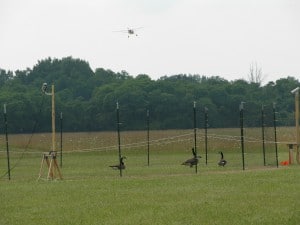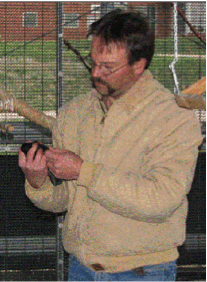Share this article
Improving wildlife damage management one sense at a time
What do disease detection, repellents, and aircraft-bird collisions have in common? All require a knowledge of how animals perceive their surroundings. Scientists at the National Wildlife Research Center (NWRC), the research arm of the USDA Wildlife Services program, have a tradition of studying sensory systems—how animals see, smell, hear, taste and touch. By understanding these mechanisms, researchers can design effective and selective damage management tools. Three examples illustrate NWRC research on sensory ecology and damage management.
Aircraft Detection and Avoidance

NWRC researchers are studying the visual systems of Canada geese to learn how they perceive approaching objects, such as airplanes. ©USDA Wildlife Services
“Escaping from threats is critical for animal survival,” states NWRC research wildlife biologist Travis DeVault. “Unfortunately, animals do not always perceive man-made objects, such as cars and airplanes, as a threat until it is too late.”
Lighting systems that exploit avian visual sensory capabilities and antipredator behavior can allow birds to react more quickly to avoid approaching objects. NWRC, Purdue University and Indiana State University scientists have confirmed that certain light wavelengths and pulse frequencies can evoke an earlier escape response in birds. Studying the flight initiation distances of several bird species when approached by vehicles of varying size and speed is helping to better understand how birds perceive and react to approaching objects. This information is useful in designing tools that maximize the chances a bird will detect aircraft and other approaching objects and initiate an appropriate escape response.
Sniffing Out Disease
In the late 20th century, scientists noticed diseased cells create a unique scent, which some animals had the ability to detect. NWRC and Monell Chemical Senses Center researchers are using this knowledge to create new diagnostic tools to detect wildlife diseases.
Over several months in 2012, mice were trained to sniff out feces from ducks infected with low pathogenic avian influenza. NWRC research chemist Bruce Kimball notes, “The mice successfully discerned between infected and uninfected feces more than 90 percent of the time.” Further experiments showed mice can distinguish whether other mice have been vaccinated.
Now, NWRC researchers are comparing odor changes caused by vaccination with those produced by inflammation to see if these changes have diagnostic potential. They are investigating the longevity of odor responses and whether odor changes can produce behavioral changes in natural systems. For instance, other studies have shown some animals avoid parasitized members of their species. Researchers will determine if vaccination also produces avoidance, which may impact wildlife vaccination programs.
Building a Better Repellent

NWRC researchers are studying the visual systems of Canada geese to learn how they perceive approaching objects, such as airplanes. ©USDA Wildlife Services
Taste, smell, sight, and tactile cues help mammals and birds identify and discriminate among foods, but play somewhat different roles in food preferences and food selection. In studies with captive red-winged blackbirds, NWRC researchers have learned blackbirds use chemosensory and feeding experiences, as well as color or visual cues, to select or avoid certain foods.
“In experiments, we saw blackbirds associate the color of food with a particular feeding experience, and then apply their past experiences to avoid toxins,” states NWRC research wildlife biologist Scott Werner.
Using this information, NWRC researchers created a unique strategy to protect crops. First, a bird repellent is applied to target crops in sufficient quantities to repel birds. Subsequent treatments include the repellent and a visual cue that exhibits an ultraviolet absorbance spectrum or color similar to the repellent. Thus future repellent treatments can be applied at significantly lower amounts. The effort has led to the patent “Ultraviolet Strategy for Avian Repellency” (US 9,131,678 B1) and a subsequent license with a private company.
Wildlife Services is a Strategic Partner of TWS.
Header Image: Scientists have learned that mice, using their sense of smell, can distinguish between vaccinated and unvaccinated mice. Photo by Monell Chemical Senses Center, Maryanne Opiekun








